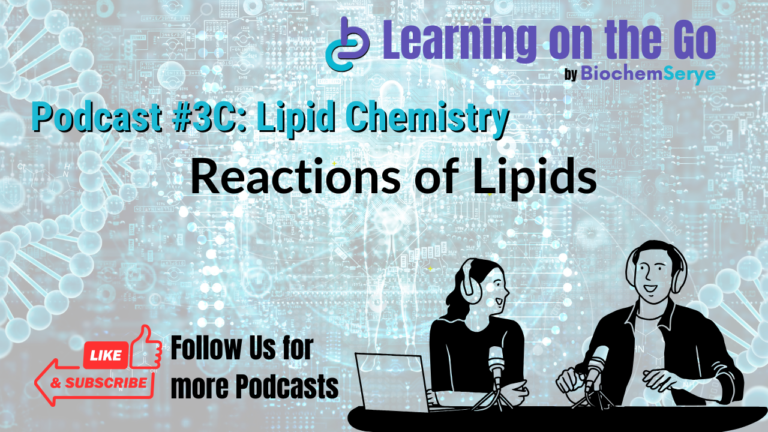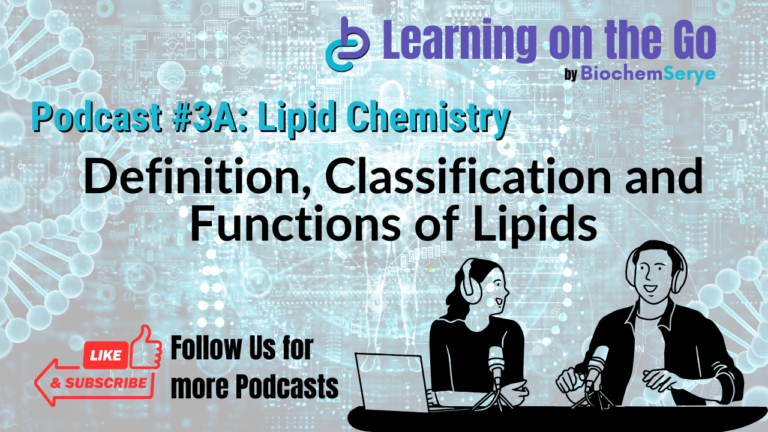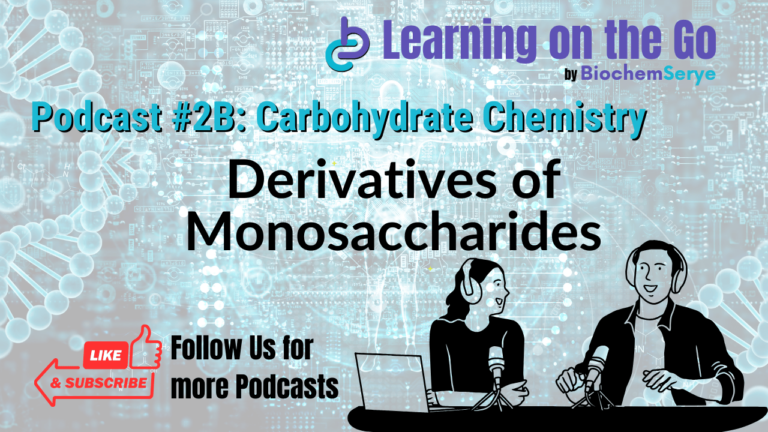Chemistry of Fatty Acids Biochemistry Notes
The Chemistry of Fatty Acids Biochemistry Notes explains the structure and function of different lipid types, including phospholipids, glycolipids, and lipoproteins, highlighting their roles in biological membranes and energy storage. These notes also cover essential fatty acids, their importance in health, and lipids’ reactions, such as saponification, hydrogenation, and peroxidation. Finally, it describes methods for characterizing and assessing the purity of fats.
Chemistry of Fatty Acids Notes Outline
Introduction
The Chemistry of Fatty Acids Biochemistry Notes summarizes key information on the chemistry of fatty acids. It covers lipid classifications, fatty acid structures, their functions, essential fatty acids, and important reactions.
Fatty Acids: Structure and Classification
Fatty acids are carboxylic acids with hydrocarbon chains. Fatty acids are carboxylic acids with hydrocarbon chains (–CH2–CH2–CH2–) and are represented by a chemical formula R-COOH, where R stands for hydrocarbon chain. The fatty acids are amphipathic, i.e. each with hydrophilic (COOH) and hydrophobic (hydrocarbon chain) groups in the structure.
Classification

- Straight-Chain: Linear carbon chains, further divided into:
- Saturated: No double bonds. Examples: palmitic acid, stearic acid (even carbon number), and propionic acid (odd carbon number).
- Unsaturated: Contain double bonds. Further divided into:
- Monoenoic (Monounsaturated): One double bond. Example: oleic acid.
- Polyenoic (Polyunsaturated): Two or more double bonds. Examples: linoleic acid (dienoic), linolenic acid (trienoic), arachidonic acid (tetraenoic), clupandonic acid (pentaenoic) and docosahexaenoic acid or DHA (hexaenoic)
- Branched-Chain: Less common; examples include isovaleric and isobutyric acid.
- Substituted: Hydrogen atoms are replaced by other groups—examples: lactic acid, carbonic acid, oxymoronic acids, and ricinoleic acid.
- Cyclic: Contain cyclic groups—example: hydnocarpic acid.

Functions of Fatty Acids
- Building blocks for phospholipids and glycolipids.
- Precursors to hormones like prostaglandins.
- The major fuel source for cells.
Fatty Acid Numbering and Double Bond Representation

Chemistry of Fatty Acids: Fatty Acid Nomenclature. From Color Atlas of Biochemistry 3rd edition.
- Carbon Numbering: Starts at the carboxyl end (C1), with carbons 2 and 3 referred to as α and β. The terminal methyl carbon is called omega (ω).

- Double Bond Designation: Two systems

- C-System: Uses ∆ (delta) with a superscript number to indicate the position of the double bond relative to the carboxyl end. Example: oleic acid is C:18:1:∆9
- ω-System: Uses ω (omega) followed by a number to indicate the position of the double bond counting from the terminal methyl group. Example: oleic acid is C:18:1:ω-9. In ω-system or n-system, the oleic acid is denoted as C: 18:1: ω-9 (Fig. 3.3) to indicate that ω-9 represents the double bond position which is found between the 9th and 10th carbon atoms, the first carbon atom being that of the terminal methyl group.
- Naturally occurring unsaturated fatty acids belong to ω-9, ω-6, and ω-3 series, for example: oleic acid (ω-9), linoleic and arachidonic acid (ω-6), and linolenic acid (ω-3).
Essential Fatty Acids (EFAs)
- Definition: Fatty acids that cannot be synthesized by the body and must be obtained from the diet. Fatty acids that are required for optimal health cannot be synthesized by the body, and should be supplied in the diet are called essential fatty acids.
- Key EFAs: Linoleic acid (ω-6) and linolenic acid (ω-3). Arachidonic acid can be synthesized from linoleic acid and becomes essential in deficiency. Humans lack the enzymes to introduce double bonds at carbon atoms beyond C9 in the fatty acid chain. Hence, humans cannot synthesize linoleic acid and linolenic acid, which have double bonds beyond C9. Thus, linoleic and linolenic are essential fatty acids.
- Functions of EFAs:
- Eicosanoid Synthesis: Precursors to prostaglandins, thromboxanes, prostacyclin, and leukotrienes.
- Structural Integrity: Important for cell membrane phospholipids and mitochondrial membrane function.
- Brain and Retina Development: Docosahexaenoic acid (DHA) is critical for neural and retinal development, especially in neonates. “DHA is particularly needed for the brain and retina development during the neonatal period. Therefore, a small daily intake of EFA is now recommended.”
- Skin Protection: Form acylglucosylceramide, which helps maintain skin impermeability.
- Antiatherogenic Effect: Help lower serum cholesterol levels. “Essential fatty acids increase esterification and cholesterol excretion, lowering the serum cholesterol level. Thus, essential fatty acids help to prevent atherosclerosis.”
- Deficiency Symptoms: Scaly skin, eczema, hair loss, poor wound healing, impaired lipid transport, fatty liver, and decreased efficiency of biological oxidation. Deficiency of EFAs is characterized by scaly skin, eczema (in children), loss of hair, and poor wound healing.
Reactions of Lipids
- Saponification: Hydrolysis of fat with alkali to produce glycerol and fatty acid salts (soaps). Hydrolysis of fat by alkali is called saponification. The products are glycerol and the alkali salts of the fatty acids, called soaps.
- Hydrogenation: Addition of hydrogen to unsaturated fats, “hardening” them. Hydrogenation of unsaturated fats in the presence of a catalyst (nickel) is known as “hardening.” It is commercially valuable to convert these liquid fats, usually of plant origin, into solid fats such as margarine, vegetable ghee, etc.
- Peroxidation (Auto-oxidation): Reaction with oxygen, leading to free radical formation and tissue damage. “Peroxidation (auto-oxidation) of lipids exposed to oxygen is responsible not only for deterioration of foods (rancidity) but also for damage to tissues in vivo, where it may be a cause of cancer. Lipid peroxidation is a chain reaction generating free radicals that initiate further peroxidation.”
- Antioxidants like vitamin E, β-carotene, and vitamin C help control peroxidation.
- Rancidity: Unpleasant odor and taste in aging fats caused by:
- Hydrolysis by lipases forming free fatty acids.
- Oxidation forms peroxides, which decompose into aldehydes.
- Antioxidants (like vitamin E in some vegetable fats) can delay rancidity.
Characterization of Fats
- Saponification Number: The milligrams of KOH needed to saponify 1 gram of fat. Inversely related to molecular weight. Higher numbers indicate shorter-chain fatty acids.
- Butter (220), Coconut oil (260).
This document provides a comprehensive overview of the chemistry of lipids and fatty acids as described in the provided source material. The key takeaways are the diversity in lipid structures, the critical functions of fatty acids in energy storage and cellular structure, the importance of EFAs for human health, and the various reactions to which lipids are susceptible (saponification, hydrogenation, peroxidation and rancidity). Understanding these concepts is fundamental to comprehending their roles in biological systems and human nutrition.convert_to_textConvert to source
Chemistry of Fatty Acids Frequently Asked Questions
What is the primary difference between saturated and unsaturated fatty acids at the molecular level?
Saturated fatty acids lack double bonds in their hydrocarbon chains, while unsaturated fatty acids contain one or more double bonds.
What does it mean for a fatty acid to be “essential,” and why can humans not synthesize these?
An essential fatty acid cannot be synthesized by the body and must be obtained from the diet. Humans lack the necessary enzymes to introduce double bonds beyond carbon 9 in the fatty acid chain.
Explain the C-system and ω-system for representing double bonds in fatty acids.
The C-system numbers carbons starting from the carboxyl end and indicate the double bond position with a delta symbol and a superscript. The ω-system numbers carbons starting from the methyl end, with omega specifying the position relative to that end.
What are the primary physiological roles of fatty acids in the body?
Fatty acids serve as building blocks for phospholipids and glycolipids, are precursors for hormones, and act as a major fuel source for cells.
What are eicosanoids, and how are they related to essential fatty acids? Give three examples of eicosanoids.
Eicosanoids are a group of signaling molecules synthesized from essential fatty acids like linoleic and arachidonic acid. Examples include prostaglandins, thromboxanes, and leukotrienes.
Describe the process of saponification and what chemical products result.
Saponification is the hydrolysis of a fat by alkali which produces glycerol and alkali salts of fatty acids called soaps.
Explain how lipid peroxidation can be harmful and describe two ways the body combats it.
Lipid peroxidation is a chain reaction that generates free radicals, which can damage tissues and is linked to cancer. The body uses antioxidants such as vitamin E and C to control this damage.
How does the saponification number relate to the molecular weight of a fat?
The saponification number is inversely proportional to the molecular weight of the fat. A high number indicates a lower molecular weight of fat, which is characteristic of short-chain fatty acids.
Chemistry of Fatty Acids Glossary of Terms
- Amphipathic: A molecule with hydrophilic (water-attracting) and hydrophobic (water-repelling) regions.
- Antioxidant: A substance that inhibits oxidation, especially used to counteract the deterioration of stored food products or the damaging effects of oxidation in animal tissues. Examples include vitamins E and C.
- C-System: A system for designating the position of double bonds in fatty acids, counting from the carboxyl end (C1).
- Complex Lipids: Lipids that contain additional groups (prosthetic groups) such as phosphoric acid, carbohydrates, or proteins. Also referred to as compound lipids.
- Cyclic Fatty Acids: Fatty acids containing cyclic (ring) structures.
- Derived Lipids: Products obtained from the hydrolysis of simple and complex lipids that still possess lipid characteristics.
- Dienoic Acid: An unsaturated fatty acid that contains two double bonds.
- Eicosanoid: A group of signaling molecules derived from essential fatty acids, including prostaglandins, thromboxanes, and leukotrienes.
- Essential Fatty Acids (EFAs): Fatty acids that cannot be synthesized by the body and must be obtained from the diet; for humans,
- these include linoleic and linolenic acid.
- Fatty Acids: Carboxylic acids with hydrocarbon chains (–CH2–CH2–CH2–), represented by the formula R-COOH.
- Glycerophospholipids: Phospholipids containing glycerol as the alcohol component.
- Glycolipids: Lipids containing fatty acid, the alcohol sphingosine, and an additional carbohydrate residue.
- Hydrogenation: Adding hydrogen to unsaturated fats often solidifies liquid fats.
- Hydrolysis: The chemical breakdown of a compound due to a reaction with water.
- Lipid: A broad term for fats, oils, waxes, and related substances that are generally insoluble in water.
- Lipoproteins: Complex molecules formed by the combination of lipids with proteins.
- Monoenoic Acid: An unsaturated fatty acid containing one double bond.
- Omega (ω) Carbon: The methyl carbon atom at the distal end of a fatty acid chain.
- ω-System: A system for designating the position of double bonds in fatty acids, counting from the terminal methyl end.
- Peroxidation: The oxidative degradation of lipids, forming free radicals and potentially damaging cells.
- Phospholipids: Lipids containing fatty acids, an alcohol, and a phosphoric acid residue.
- Polyenoic Acid: An unsaturated fatty acid containing two or more double bonds.
- Prosthetic Group: A non-protein group covalently bound to a protein or a complex lipid.
- Rancidity: The development of unpleasant odors and tastes in fats due to hydrolysis or oxidation.
- Saponification: The alkaline hydrolysis of a fat or oil to produce glycerol and soap (salt of a fatty acid).
- Saponification Number: The number of milligrams of KOH required to saponify one gram of fat.
- Saturated Fatty Acid: A fatty acid with no double bonds in the hydrocarbon chain.
- Sphingolipids: Lipids containing the amino alcohol sphingosine.
- Sphingophospholipids: Phospholipids containing sphingosine as the alcohol component.
- Straight Chain Fatty Acids: Fatty acids in which the carbon atoms are arranged linearly.
- Substituted Fatty Acids: Fatty acids in which another group has replaced one or more hydrogen atoms.
- Trienoic Acid: An unsaturated fatty acid that contains three double bonds.
- Unsaturated Fatty Acid: A fatty acid containing one or more double bonds in the hydrocarbon






